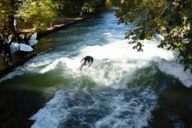
Munich is a city of tolerance and diversity, as you’ll soon see when you explore our insider tips for each neighbourhood. There are tango dancers in the square at Königsplatz, boules players at Hofgarten, and surfers on the Eisbach, next door to the Haus der Kunst art gallery – all of them long-established icons of the city.
On balmy summer evenings, the entrance to the Antikensammlungen (State Museum of Classical Art) is transformed into a dance floor: on the 100-square-metre shell limestone floor, 15 to 30 couples dance to the melancholic strains of tango music. One of the organisers, dance teacher Levent Göksu, works with a few like-minded dance fans to organise the colourful event, which has been running for three years and takes place on any day when the temperature exceeds 20 degrees.
Across the square, the Glyptothek art museum and the Propyläen gate (which is based on the Athens city gates) provide the perfect backdrop for the passionate performance. Between 5 and 7 p.m., there are free workshops (if you like, you can even throw your own hat into the teaching ring), after which things really get going – tango professionals spin and sway alongside absolute beginners.
Click, clack, wow! Anyone who takes a stroll through the Hofgarten arcades is sure to be met with a cacophony of sounds, including metal striking metal and cries of celebration. For a good 40 years or so, the wide gravel path between the Hofgarten hedges and the arcades has been a refuge for petanque players, who meet every evening in groups of varying sizes. In this sociable game, players aim to get their metal balls as close as possible to the target ball, known as the “Cochonet” or in Bavarian, “der Sau” (“the pig”).
Perfecting your throwing technique is key. You may either roll the ball (also known as “placing” it by the experts) or throw it up in the air (“shooting”). Every summer for the past 35 years, the Hofgarten has hosted a tournament held by the “1st Münchner Kugelwurfunion – Pétanque Munichoise e.V.” boules club. In 2016, 634 participants attended the event – so many, that some groups had to relocate to the neighbouring Finanzgarten.
When the documentary “Keep Surfing” (2009) was released, its subject became so iconic that surfers travelled from all over the world to ride it: the Eisbachwelle river wave in the Englischer Garten. Where else in the world can you perform artful twists and turns on your surfboard, in front of crowds of intrigued spectators and in the heart of a city of millions? Since the 1980s, the side arm of the Isar – where 27 cubic metres of water shoots out of a walled twin arch every second, to create a standing wave – has been decisively colonised by surfers.
These days the wave is the world’s most famous spot for river surfing – drawing huge crowds to the spot near the Haus der Kunst art gallery, as you would expect. Sometimes there are more than ten surfers queuing on both sides of the stream – they take turns using the zipper merge principle. Watch out for the next person in line clapping their hand against their board – that’s the signal for the current wave rider to relinquish their spot.